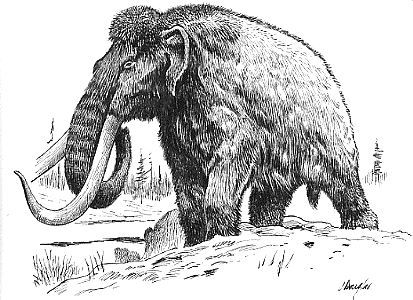By Richard A. Kerr, Science Now, March 5, 2012
The past few tens of millennia were hard times for the
"megafauna" of the world. Hundreds of big-bodied species—from the
mammoths of North America to the 3-meter-tall kangaroos of Australia to the
200-kilogram-plus flightless birds of New Zealand—just disappeared from the
fossil record. A new, broad analysis continues the century-long debate over the
loss of the big animals, coming down on the middle ground between blaming
migrating humans for wiping them all out and climate change alone for doing
them in.
As in most contentious scientific debates, uncertainties
in the data have fueled the dispute over what took out the megafauna.
Typically, researchers would try to pin down exactly when, say, the mammoths of
North America died out, when the climate changed the fastest as the world came
out of the last ice age, and, most difficult, when humans from Asia first
arrived on the scene. If the extinction in a particular area seemed to coincide
with severe climate change or with the arrival of humans, one or the other
could be blamed. If it seemed to have been the humans, researchers assumed the
new arrivals must have hunted down too many mammoths, brought a lethal disease
with them, or altered the environment somehow, perhaps by too much burning.
But the case-by-case tactic has not yet carried the day
for either side. So zoologists Graham Prescott and David Williams and their
colleagues at the University of Cambridge in the United Kingdom decided to take
a broader approach. In a paper published today in the Proceedings of the
National Academy of Sciences, they lay out their analysis of the
extinction of 110 genera of megafauna on five landmasses in relation to the timing of four
kinds of climate change and the arrival of humans.
The Cambridge group compiled dates from previous studies
for the arrival of humans and the extinction of megafauna on each landmass:
Australia, Eurasia, New Zealand, North America, and South America. And they
took the temperature record locked in an Antarctic ice core as a guide to
global climate change. Then they compared how well climate change and human
arrivals, alone or in combination, could predict the timing and severity of
extinctions on the five landmasses. To sort out the importance of timing
uncertainties, they tested 320,000 different extinction scenarios. "We
tested a lot of models across a huge range of human arrival times and
extinction times," Prescott says. "It seems likely that both climate
and human factors played a role" in most cases.
"What they found makes sense," says mammalian
paleoecologist Anthony Barnosky of the University of California, Berkeley.
"It makes a clear case for there being an interaction. It shows what
happens when two bad things happen at once." Barnosky and environmental
scientist Barry Brook of the University of Adelaide in Australia have found
such a human-climate synergy operating in megafaunal extinctions when severe
climate change coincided with human arrivals. A similar synergy is happening
today, they say, as global warming intensifies and the human population
continues to grow.
But others have concerns about the latest study—for example, the
way it lumps together events occurring as much as 10,000 years apart to test
for coincidence. "When you have such a challenging problem, what are you
willing to ignore in the details to get the big picture?" asks ecological
statistician Andrew Solow of Woods Hole Oceanographic Institution in
Massachusetts. "I'm worried that too much of the detail was omitted. This
is a first step."

No comments:
Post a Comment